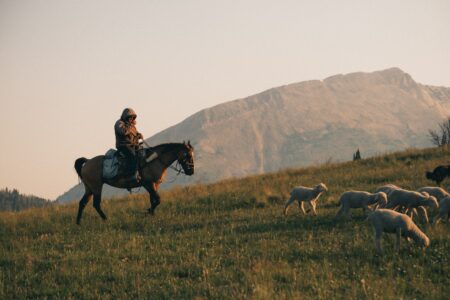Green Success Stories puts Mike Somerby, CMO of Duckworth, in the Green Spotlight. Mike describes the deep-rooted sustainability foundations of their merino wool products, built on generations of care and regenerative practices for the Montana sheep ranch from which the company derives its natural and sustainable product line. He looks forward to the time when the apparel industry and consumers in general move away from petroleum-based clothing products that are harmful for the environment, and return to the natural and high-quality material that Duckworth offers.

Tell us a bit about your sustainability journey.
We find ourselves laughing, from time to time, about the words “regenerative” and “sustainability” and other concepts like those being touted as new mantras of doing business (particularly businesses predicated on an agricultural foundation). Why? We’ve been working our ranch in Montana now for four generations, nearly a century of continued stewardship of those lands, and harvesting a sustainable fiber for apparel application. These are not new concepts for us – if we were to work our land in anything but a regenerative or sustainable fashion, the arid and high-desert conditions of Southwest Montana would quickly turn these lands into a dustbowl. Ecologically, this would be disastrous, and as far as passing the torch to the next generation would go, they’d be needing to find work elsewhere. We’ve always endeavored to avoid these perils. And for that reason, our sustainability journey extends far beyond the genesis of Duckworth – a USA-made wool gear and apparel brand founded by those very same ranchers – and is indeed worked into the bones of what we do for 100 years. Independently and in concert with international groups such as The Nature Conservancy, we tend to our lands and animals in ways that center on long-term health for all involved, from native plants and animals to customers far down the supply chain road.
Tell us a bit about the product or solution you offer.

Duckworth creates versatile merino wool products made exclusively in the USA with Montana-grown wool, produced by its co-founders and fourth-generation sheep ranchers,
Our merino wool goods are forged with merino wool clipped straight from the backs of our mountain- and prairie-fording herds of sheep, some 10,000 strong. Plastic as the primary textile in clothing has had a run of about 60 years and we’re already looking, societally speaking, for ways to get rid of it. In other words, plastic textiles have far from stood the test of time. Our merino wool gear, on the other hand (especially our 100% merino lines, as we do sometimes incorporate textile fiber blends for performance benefits) are built to last.

Share a green success story with us – how have you helped customers or other businesses in the fight against climate change?
To further the above prompt, by buying a renewable and sustainable fiber – grown year-in and year-out on the backs of our sheep – you are actively choosing a clothing model that is phasing out fast fashion and synthetic textiles. Moreover, our USA-made supply chain removes tens-of-thousands-worth of emissions miles from the supply chain equation. For example, a leading competitor of ours taps six continents and no less than 12 countries spread across the globe to complete their supply chain. Why even bother, at that point, to use a renewable textile? Surely, the emissions in that chain outweigh the benefits, what with the staggering reliance on international shipping and overland movement of raw and finished goods.
What would you do with $1 billion dollars?
We would likely look to invest in the American apparel manufacturing space. After decades worth of apparel businesses and other manufacturing verticals moving their operations overseas for cheaper labor, loose workplace regulations and workers’ rights, and potentially nonexistent environmental regulations, the USA-made manufacturing industry is on the ropes. In order for our domestic manufacturing to be both vibrant, diverse and relatively cost-effective we need to increase options for businesses looking to manufacture here, stateside, versus overseas.
What do you envision your industry looking like in ten years?
Ideally, we’ve carved a serious foothold out for both the American wool and American garment manufacturing industries. There are serious and challenging bottlenecks currently featured in all USA-made supply chains (particularly those of wool, flax, hemp and jute), as we have a primarily “cottonized” system that favors cotton above all else. Synthetics, too, have some production reliability in the USA. So we hope to have fostered a climate in which renewable textiles outside of just cotton have plenty of breathing room and innovation. It’s hard to say what 10 years might spell, but the recent spate of tariffs (if they hold) will encourage businesses to reshore, and with that there will be refreshed investment in the desperately ailing workforce and machinery needed to ensure smoothness.
What would you like readers to take away from this article?
Wool: It’s been with us (civilization) for some 13,000 years. Plastics? Just sixty, and we’re already scrambling to oust it from our consumer goods. Telling.
How should readers get in touch with you and/or your organization?
Reach out at [email protected]
Kudos
Many thanks to Mike Somerby and Duckworth. Green Success Stories is happy to support and highlight your efforts! We invite you the reader to do the same.
About Green Success Stories
Green Success Stories is a media platform that highlights leaders in sustainability and climate tech.
We offer professional writing (articles, blogposts, case studies, and more) combined with social media promotion. You get great content + exponential publicity. As a starting offer, we’d like to feature you and your organization in a FREE PROFILE ARTICLE. There’s no obligation, but we’d appreciate you considering our services. Let us know if you’re interested and we’ll share more information.
Support Green Success Stories
Like what we’re doing? Please pitch in and help us highlight leaders in the fight against global warming.





